Threat classifications play an important role in monitoring biodiversity and informing conservation actions.
The Department of Conservation | Te Papa Atawhai (DOC) is tasked with managing indigenous species nationally, but regional and district councils have statutory obligations to maintain indigenous biodiversity under the Resource Management Act 1991 (RMA), including to manage the habitats of threatened species.
Nationally, the New Zealand Threat Classification System (NZTCS) is used to assess species and is administered by DOC on behalf of all New Zealanders.
The regional threat classification system leverages off the national assessments in the NZTCS, providing information relevant for the regional context. For example, a key requirement of managing the habitats of threatened species is to understand regional distributions and population sizes.
ORC has completed several regional threat assessments, with plans for more in the near future.
A total of 1304 indigenous vascular plant species listed in the New Zealand Threat Classification System (NZTCS) were identified as occurring naturally in Otago. This large flora confirms Otago as one of the botanically most diverse regions in Aotearoa New Zealand, containing a high proportion of the national flora.
The species in Otago listed in NZTCS have been assigned to the following regional threat categories:
- 249 Regionally Threatened (Regionally Critical = 98; Regionally Endangered = 78; Regionally Vulnerable = 73)
- 297 are Regionally At Risk (Regionally Declining = 54; Regionally Naturally Uncommon = 243)
- 598 were Regionally Not Threatened
- one as Regionally Non-resident Native (Regional Coloniser = 1)
- 149 are Regionally Data Deficient
- 10 species are identified as having become Regionally Extirpated (i.e., have become extinct in the region)
A further 17 species were identified that had not been assessed in the NZTCS.
Otago was identified with 40 vascular plant species that are regional endemics, meaning they are only found in the region. Of these endemic taxa, 31 have heightened risks of extinction nationally (Nationally Threatened or Nationally At Risk categories). A total of 330 species were identified as having national strongholds in Otago (where 20% of the population are found in a region). This includes 187 taxa with a heightened risk of extinction nationally.
ORC completed this update of the regional conservation of indigenous vascular plants in 2025, in conjunction with a panel of experts including John Barkla, Brian Rance, Dr Geoff Rogers, Richard Ewans, and Dr Mike Thorsen.
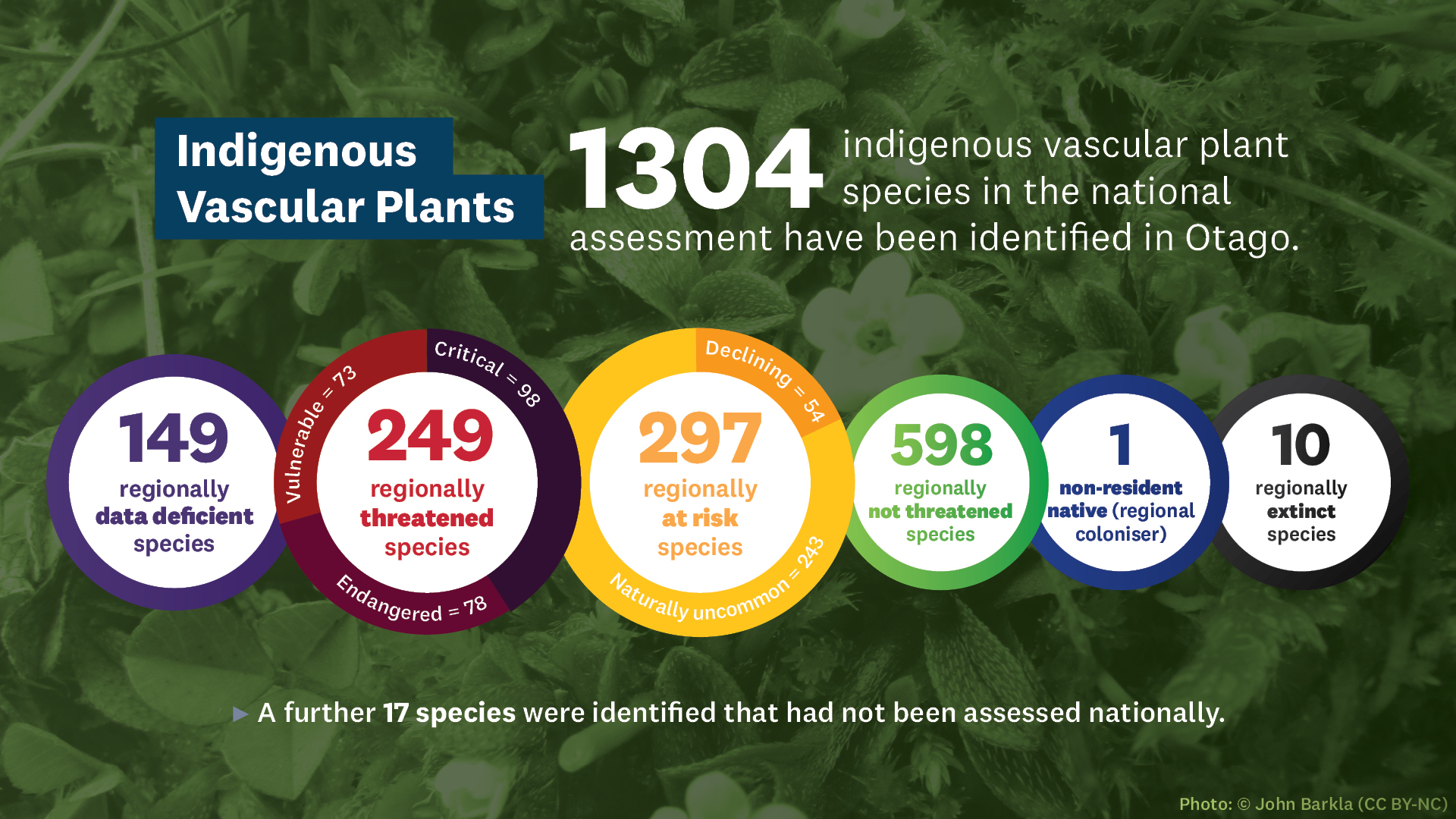
A total of 287 bird species were listed in the Otago Region.
In the regional conservation status for birds the following assessments were made:
- 32 were Regionally Threatened (Regionally Critical = 9; Regionally Endangered = 6; Regionally Vulnerable = 17)
- 4 were Regionally At Risk (Regionally Declining = 3; Regionally Recovering = 1)
- 139 were Regionally Non-resident Native (Regional Migrant = 37; Regional Vagrant = 100; Regional Coloniser = 2)
- 23 were Regionally Not Threatened
- 25 were Regionally Introduced and Naturalised
- 9 were Regionally Data Deficient
- 43 were Regionally Extirpated, i.e., 30 were globally extinct and 13 were regionally extinct
- 4 were Conservation Translocations, where they have been deliberately moved for conservation benefit: three of these were reintroductions while one was a conservation introduction
In addition, ten species were identified as ‘Introduced, Not Established’. This is where a release has been documented, but there is no self-sustaining population in the wild or a deliberate introduction has been documented, and published records indicate the species bred (or probably bred), but it is no longer around. Two species were 'Not Assessed' but have been assessed in earlier national assessments.
Otago serves as a national stronghold for eight bird species, meaning more than 20% of the national population is here in the region. They include migratory shorebirds and domestic migrants, emphasising the region's critical role in preserving these species. One species was endemic to the Region, the Otago shag/matapo. This species only currently breeds in our Region but can be seen outside of Otago.
ORC completed this update of the conservation status of birds in Otago in 2025 with a panel of experts from the Department of Conservation | Te Papa Atawahi (Bruce McKinlay), University of Otago | Ōtākou Whakaihu Waka (Dr Nicolas Rawlence and Oscar Thomas) and Otago’s Regional Representative for Birds New Zealand (Dawn Palmer).
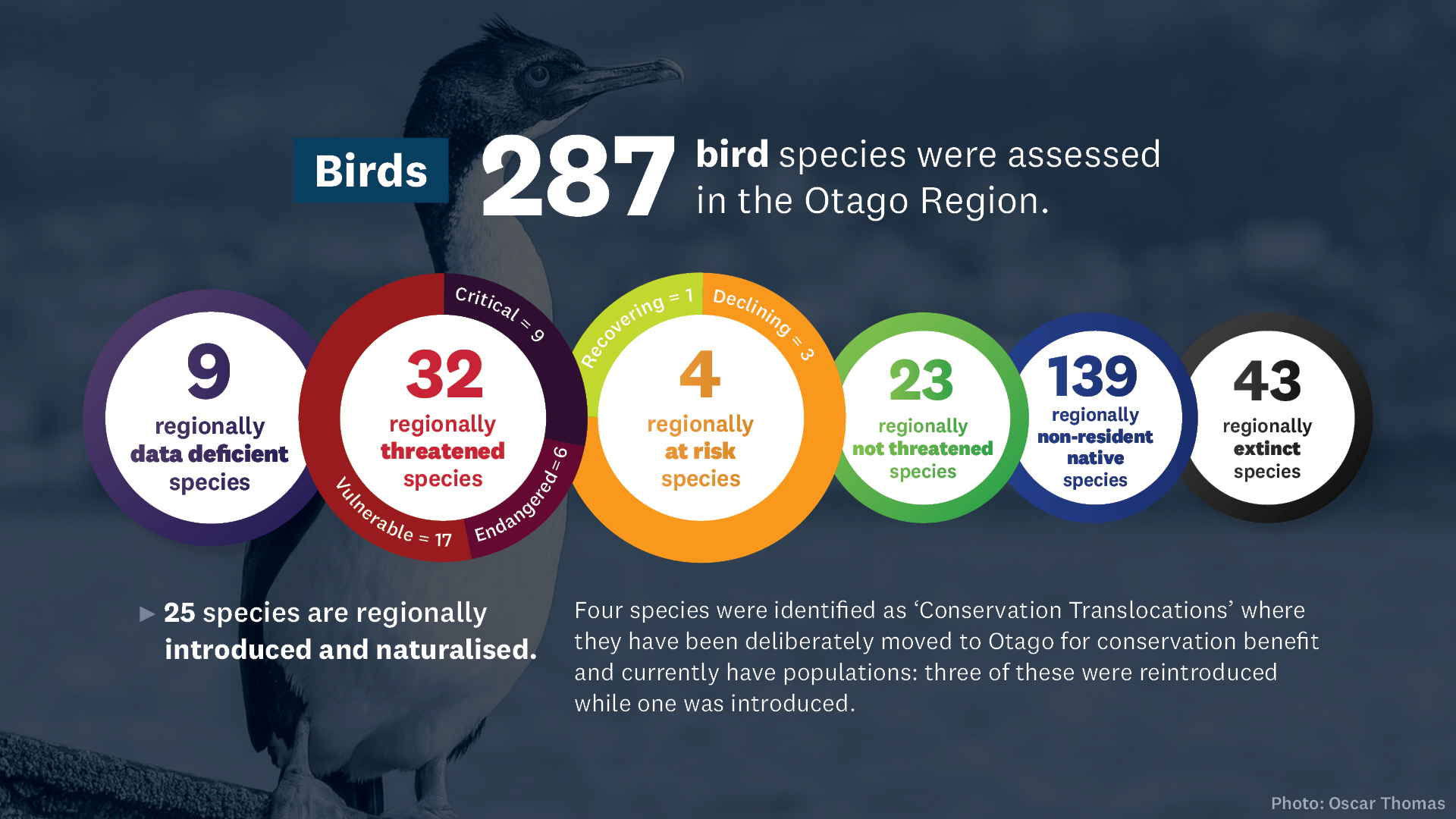
A total of 35 reptile species were assessed in the Otago Region, including 18 skinks, 13 geckos, three sea turtles, and tuatara.
In the regional conservation status for reptiles the following assessments were made:
- 14 were Regionally Threatened (Regionally Critical: 2; Regionally Endangered: 4; Regionally Vulnerable: 8)
- 16 were Regionally At Risk (Regionally Declining: 16)
- one was Regionally Not Threatened
- three were Regionally Non-resident Native (Regional Vagrant: 3)
- two terrestrial reptile species were Regionally Extirpated, i.e., extinct in the Region, with one of them being reintroduced back into the Region (tuatara)
The Region was identified as a National Stronghold (>20% national population) for 25 of the 32 resident species (~78%), i.e., lizards (skinks and geckos) and tuatara.
Six of species are regional endemics, meaning they are found nowhere else, including the Burgan skink (Oligosoma burganae), grand skink (O. grande), Kawarau gecko (Woodworthia “Cromwell”), Otago skink (O. otagense), schist gecko (W. “Central Otago”), and Raggedy Range gecko (W. “Raggedy”).
ORC completed this update of the regional conservation status of reptiles in 2025, in conjunction with a panel of experts from the University of Otago – Ōtākou Whakaihu Waha (Dr Jo Monks), Department of Conservation Te Papa Atawhai (Dr James Reardon), Samuel Purdie (Southern Lakes Sanctuary), and Southern Scales (Carey Knox).
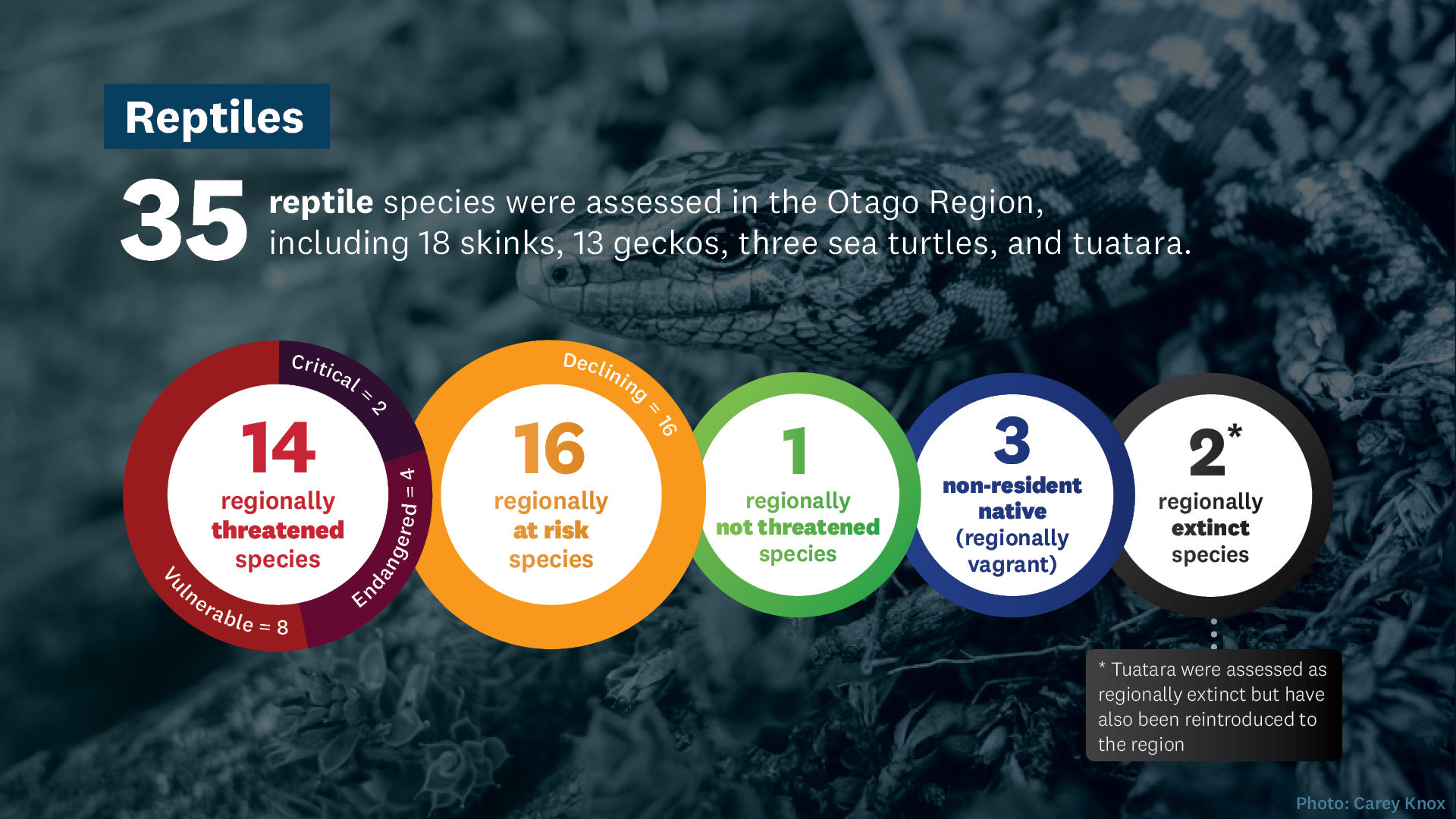
Two bat species were identified as present in, or near, the Otago Region: the pekapeka-tou-roa, the long-tailed bat, and pekapeka-tou-poto, the southern lesser short-tailed bat.
In the regional conservation status for bats the following assessments were made:
- the pekapeka-tou-roa/long-tailed bat (Chalinolobus tuberculatus) was assessed as Regionally Critical, the most severely threatened status
- the pekapeka-tou-poto/southern lesser short-tailed bat (Mystacina tuberculata tuberculata) was assessed as Regionally Data Deficient, due to information lacking so that an assessment was not possible. While the southern lesser short-tailed bat could potentially be present in the Otago region, based on records less than 2 km from the western boundary of Otago and the bat’s flight range, there are no recent records of it in our region.
An additional species, the greater short-tailed bat (Mystacina robusta) was identified as Regionally Extirpated, i.e., extinct in the Region. This species has been assessed as Data Deficient in the NZTCS, because it has not been seen since 1967, with this happening outside Otago, although anecdotal reports have occurred more recently from outside the Region.
ORC completed the first regional conservation status of bats in 2023, in conjunction with a panel of bat experts from DOC (Moira Pryde), Royal Forest and Bird Protection Society (Catriona Gower), and independent consultants (Dr Gillian Dennis and Dr Ian Davidson-Watts).
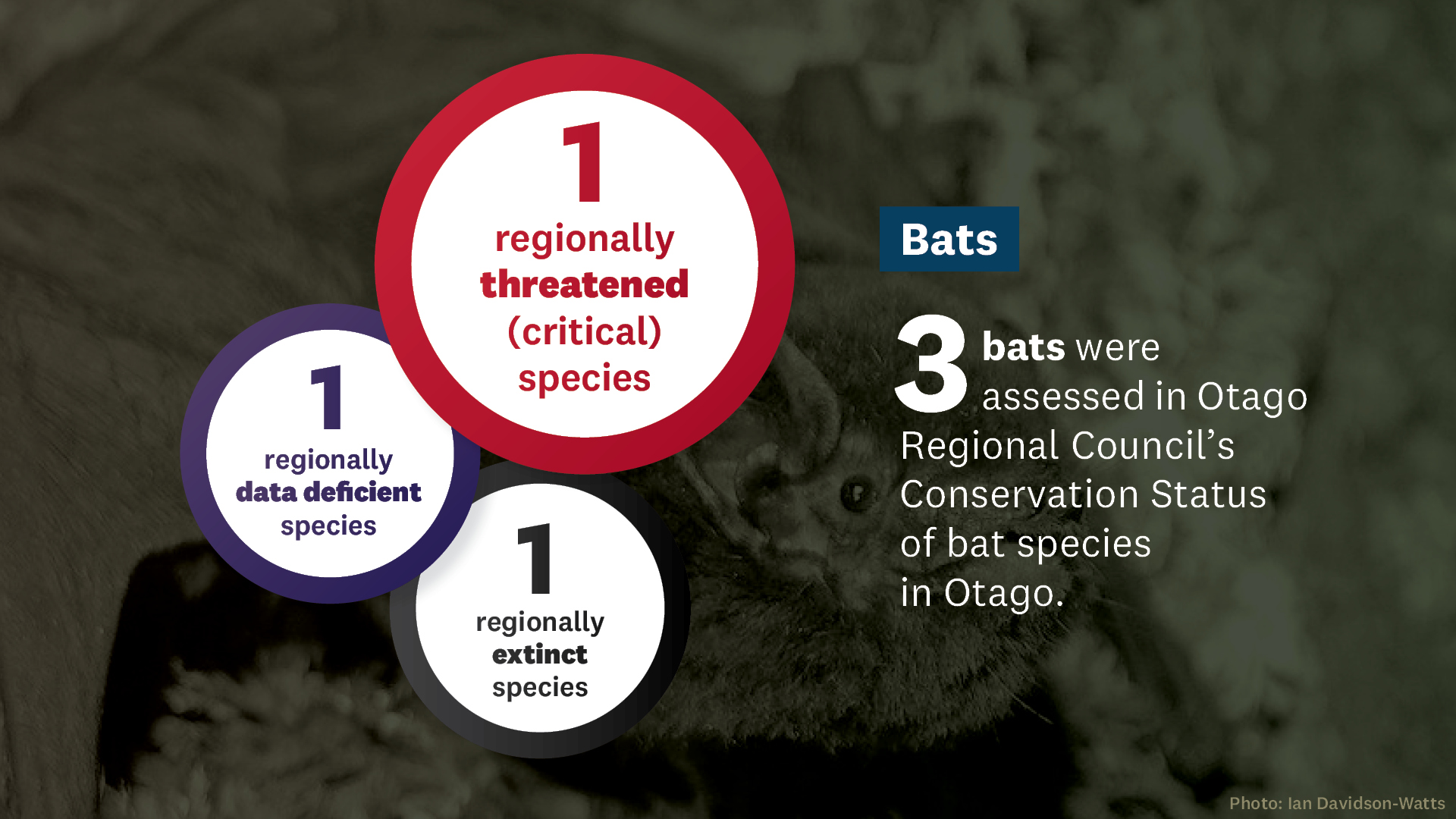
A total of four species of Onychophora, also known as peripatus or velvet worms or ngāokeoke, listed in the New Zealand Threat Classification System were identified as present, or near, the Otago Region.
In the regional conservation status for Onychophora the following assessments were made:
- three species were Regionally Not Threatened (Peripatoides otepoti, P. taitonga and Ooperipatellus viridimaculatus)
- one species as Regionally Data Deficient (P. Waikaia; currently documented only from native forest towards the head of the Waikaia River just outside Otago’s boundary).
ORC completed the first regional conservation status of Onychophora in 2025.
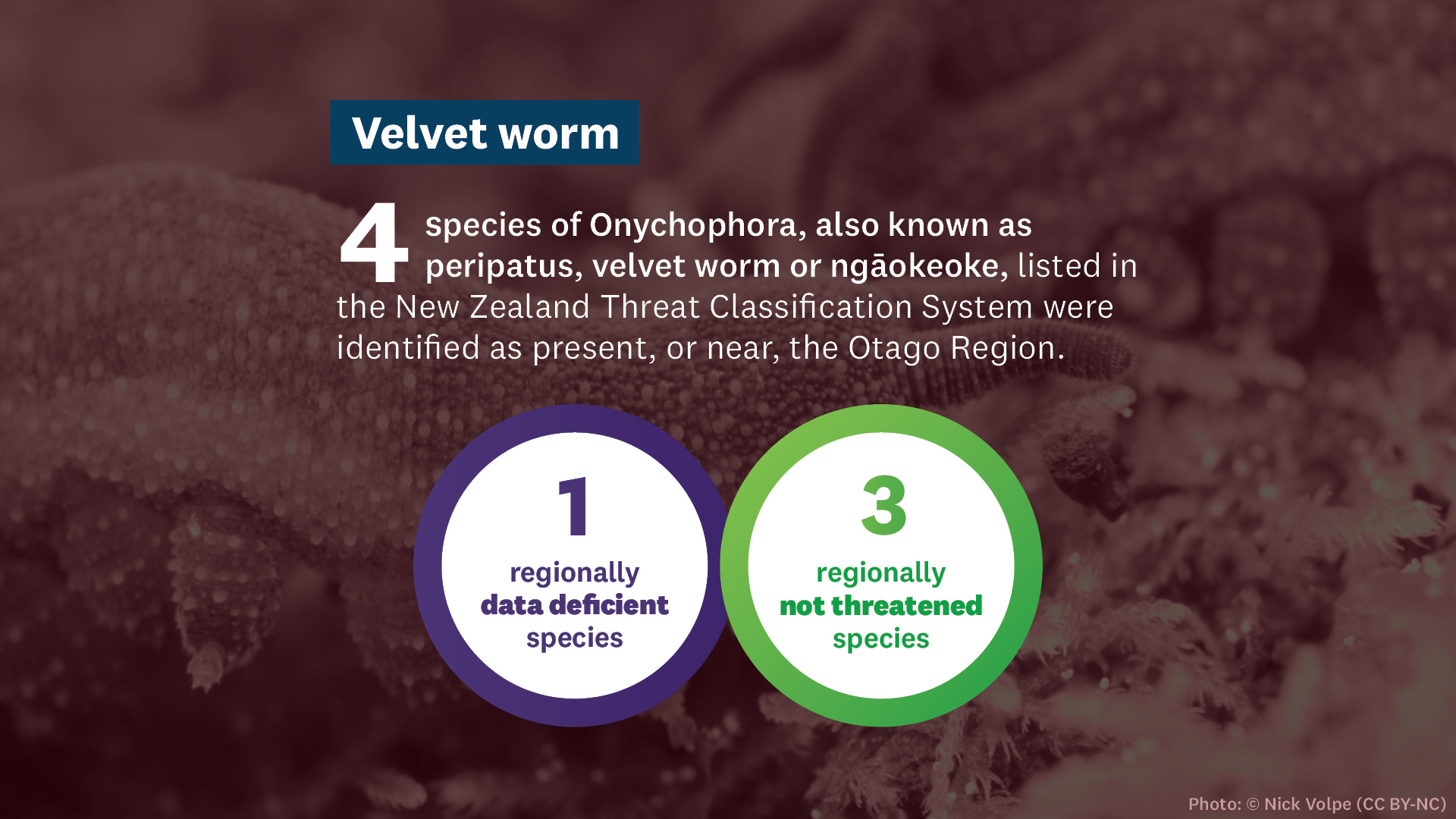
May 2025
PDF | 1 MB
Otago Threat Classification Series 8: Onchyophora (‘peripatus’ or velvet worm)
May 2025
XLSX | 58 KB
Otago Threat Classification Series 8: Onchyophora (‘peripatus’ or velvet worm). Supplementary Information May 2025
A total of 331 selected species of non-lichenised agarics, boletes and russuloid fungi in the Otago Region were identified from the national checklist. A general process for assessing the threat of extinction of fungal taxa is described in the report at the regional level.
In the regional conservation status for select fungal taxa the following assessments were made:
- Nine were Regionally Threatened (Regionally Critical = 1; Regionally Vulnerable = 8)
- 203 were Regionally Not Threatened
- 119 as Regionally Data Deficient.
ORC completed the first regional conservation status of the selected species of non-lichenised agarics, boletes and russuloid in 2024, with the assistance of a fungi expert from Manaaki Whenua – Landcare Research (Dr Jerry Cooper).
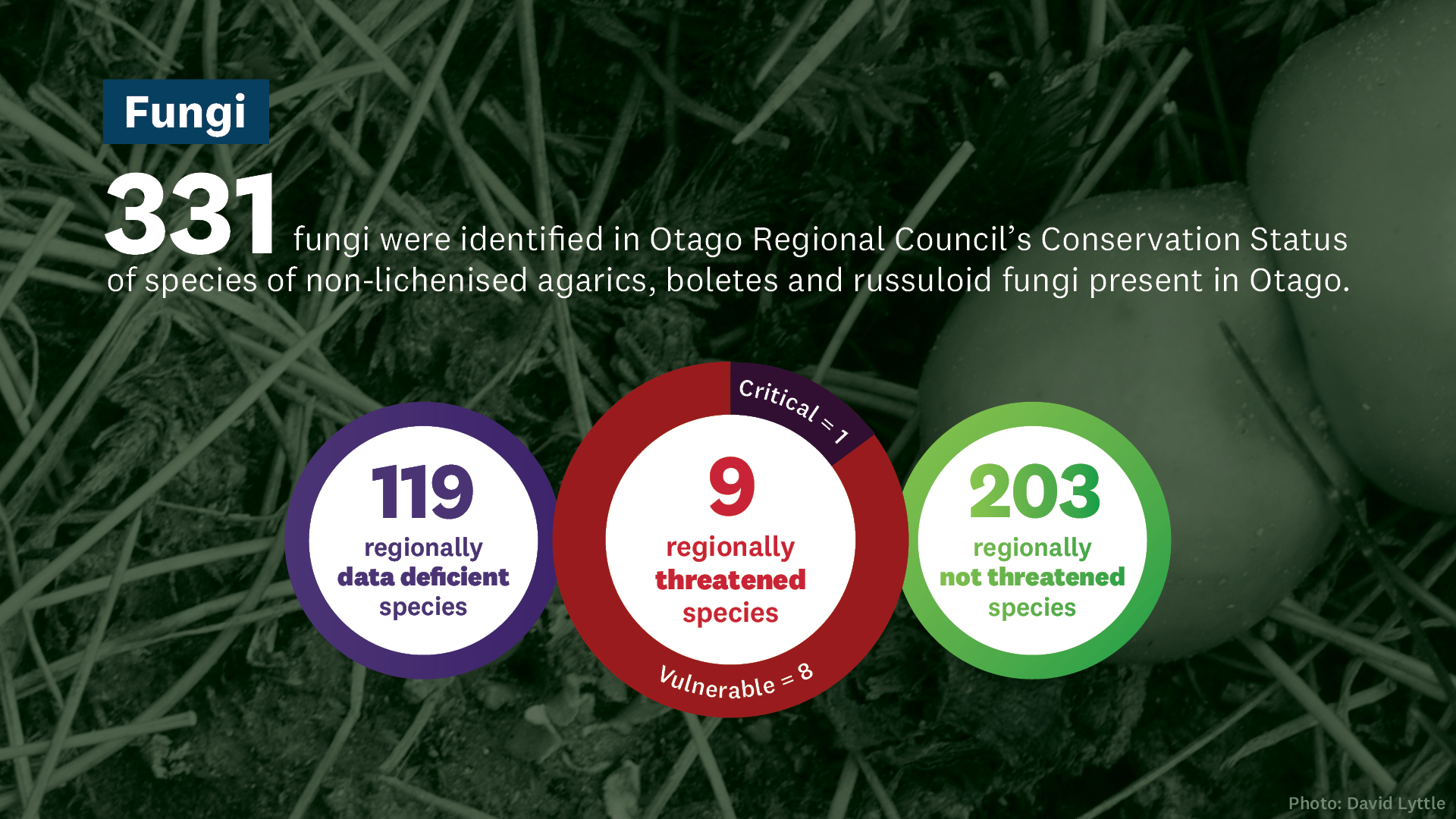
October 2024
PDF | 2 MB
Otago Threat Classification Series 7: Mushroom fungi
October 2024
XLSX | 86 KB
Otago Threat Classification System Series 7: Mushroom fungi - Supplementary Information
A total of three amphibians listed in the New Zealand Threat Classification System were assessed in Otago.
In the regional conservation status for amphibians the following assessments were made:
- two were Regionally Introduced and Naturalised (brown tree frog, Litoria ewingii, and southern tree frog, Ranoidea raniformis)
- one was Regionally Extirpated, i.e., extinct in the region (Markham's frog, Leiopelma markhami).
The green and golden bell frog (Ranoidea aurea) has been recorded, although no confirmed evidence for ‘naturalised’ populations exists yet, i.e., multi-generational with spread. Thus, it was not assessed as Regionally Introduced and Naturalised.
ORC completed the update to regional conservation status of amphibians in 2025.
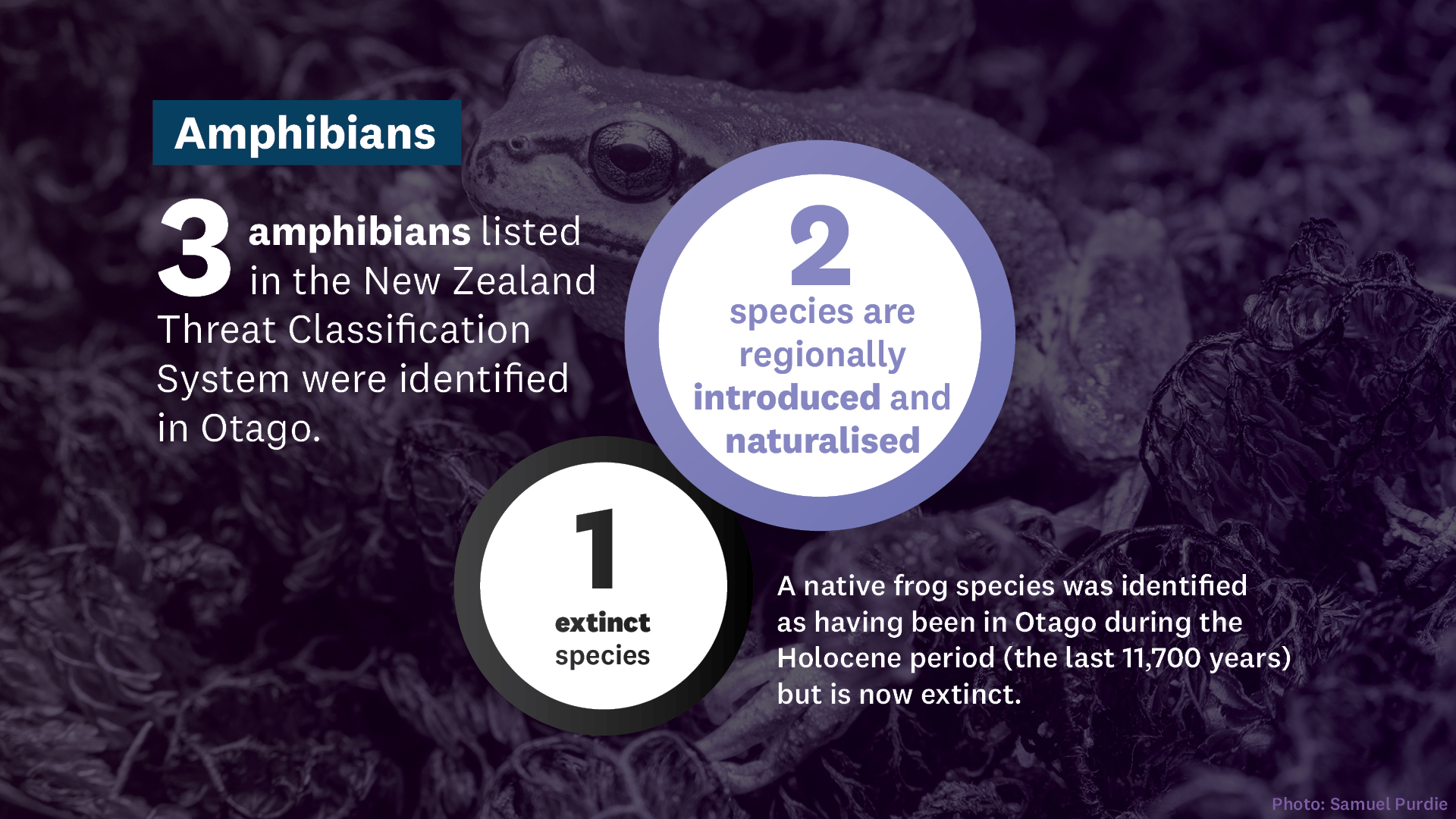
April 2025
PDF | 1 MB
Otago Threat Classification Series 10: Amphibians
April 2025
XLSX | 61 KB
Otago Threat Classification Series 10: Amphibians. Supplementary Information

Amphibians
Ika oneone or amphibians are small vertebrates that need water, or a moist environment, to survive.

Bats
Pekapeka or bats are Aotearoa New Zealand’s only native land mammals.

Bees
Ngaro huruhuru or native bees are relatively small, non-aggressive and mostly solitary

Birds
Manu or birds are the only living vertebrates with feathers.

Fungi
Hekaheka or fungi are not plants or animals, forming their own separate diverse kingdom, including mushrooms, toadstools, puffballs, yeast, bread mould and skin infections.

Plants - vascular
Nakinaki or vascular plants have a specialised system of tubes to distribute resources throughout the plant.

Plants - non-vascular
Non-vascular plants are those without a vascular system and grow from spores. They include bryophytes (mosses, liverworts and hornworts) and algae.

Reptiles
Ngārara or reptiles are vertebrates covered in special skin made up of scales, bony plates, or a combination of both.

Spiders
Pūngāwerewere or spiders are eight-legged creatures known for making silk webs.

Velvet worms
Ngaokeoke or peripatus or velvet worms are little-known nocturnal invertebrates of Aotearoa New Zealand’s undergrowth
Media release: Bats identified as severely threatened in Otago
Media release: Report reveals high risk of extinction to Otago reptiles
Media release: Otago is one of NZ’s most botanically diverse regions
Media release: ORC shares first conservation status assessment for birds in Otago








